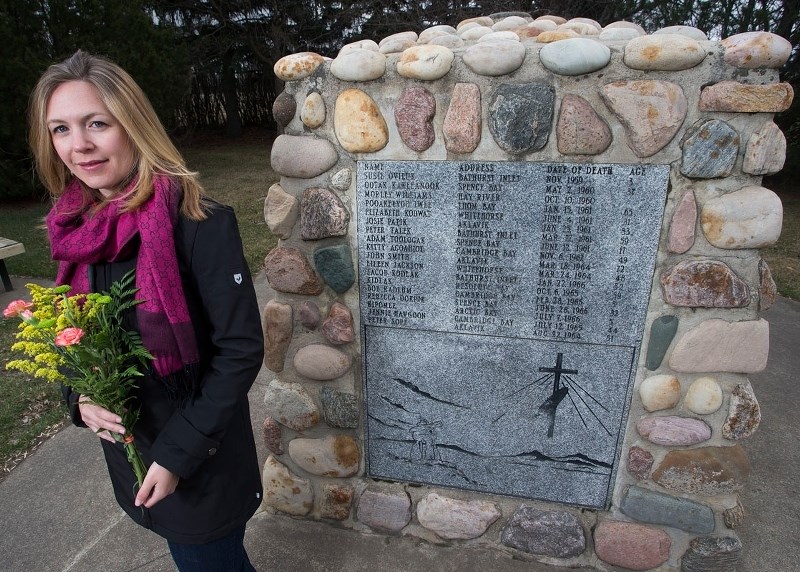If you’ve never heard of Indian hospitals, you’re not the only one. This is one particular dark issue in Canada’s past that isn’t often spoken about, even though the story comes right into St. Albert’s backyard.
The issue is so little-known, in fact, that Edmonton historian Danielle Metcalfe-Chenail had never heard of them until she came upon references to X-Ray Tours while researching a book in Canada’s northern territories – and she has a masters degree in history focusing on contact relations.
“I thought I was pretty up to speed on things like residential schools, missionaries, treaties and things, but I had never heard of Indian hospitals up to that point,” she said.
When a recent grant opportunity gave her the opportunity to do some further research, she jumped on it. Her findings led her from the Camsell Hospital in Edmonton right to the St. Albert Cemetery.
Metcalfe-Chenail has published a blog called The Ghosts of Camsell that tells part of the story of the X-Ray Tours, life at the Camsell and the burial ground on the site of what was, at the time, the Edmonton Residential School on the site of what is now Poundmaker’s Lodge.
A stone cairn commemorates 98 people who left their homes in Canada’s far north, many of whom had been diagnosed with tuberculosis once X-ray machines were brought by plane to their remote communities. These were people who died in what was then known as the Camsell Indian Hospital.
“I thought those were some very specific stories and people that could be a window into this history,” she said.
It was actually a Google search that first told her of the gravesite’s connection to the Camsell, and pointed her to the MusĂ©e Heritage Museum, where she discovered a box full of records before looking into the names on the cairn itself.
The process began in 1947, when an annual tuberculosis vaccination and X-ray program was launched, at first along the Alaska Highway in the Yukon. Eventually the tour was brought to many remote communities by air, including places like Spence Bay (Taloyoak), Cambridge Bay, Resolute Bay – in what was then the Northwest Territories and now Nunavut – and many others.
Those diagnosed were brought to hospitals like the Camsell to recuperate, but at the time the best they could offer was what was known as a rest cure, meaning some patients were in the hospital for years.
Many of those who never recuperated were buried at the St. Albert Cemetery, and many of their names are on a cairn that was erected nearly 25 years ago. When Metcalfe-Chenail started looking a bit more closely at those names, what she discovered was unsettling.
“One of the biggest surprises was how many of those names were children,” she said. “I did a tally of kids under four, and it ended up being 31 out of the 98 names, and a lot of them were newborns or infants.”
Some of the women brought to the Camsell were pregnant, and others became pregnant during their stay. Children born to mothers suffering from tuberculosis often are born with symptoms of the infection.
Given the sensitive nature of her research, Metcalfe-Chenail opted to publish her research as a serial, with updated entries every day over the process of three weeks. She said she wanted to be cautious about telling a story that for many is still troubling, and she wanted to avoid reopening old wounds.
But as she published more and more, her audience grew to include many from the far-north communities she was writing about, and in most cases people were excited about her work and wanted to know more.
“There are people who emailed me or commented on the posts, who are still looking for their aunts, their uncles, their grandparents,” she said. “They still have no idea where they went.”
It’s a story she said she intends to research much further, suggesting the history of Indian hospitals would come to the forefront as stories about Canada’s sometimes-dark past in the same way disturbing stories of the residential school system are now widely told.
Metcalfe-Chenail said as a historian, the important thing for people to remember from all this is that we are still connected with the past, sometimes in more ways than we would like to acknowledge.
In telling the story, however, she said we can begin to understand how all our different histories intertwine and get a greater understanding of how to move forward into the future without ignoring our past as it bleeds into the present.
“This isn’t over and done with,” she said. “These are questions we’re still wrestling with.”
In order to further record the stories surrounding this important piece of Edmonton’s history, Metcalfe-Chenail has planned a recording session at the Stanley Milner Library in Edmonton on May 19 to capture some of the oral histories from anyone who has a connection to the Camsell.
For more information about her research project, visit ghostsofcamsell.ca.




